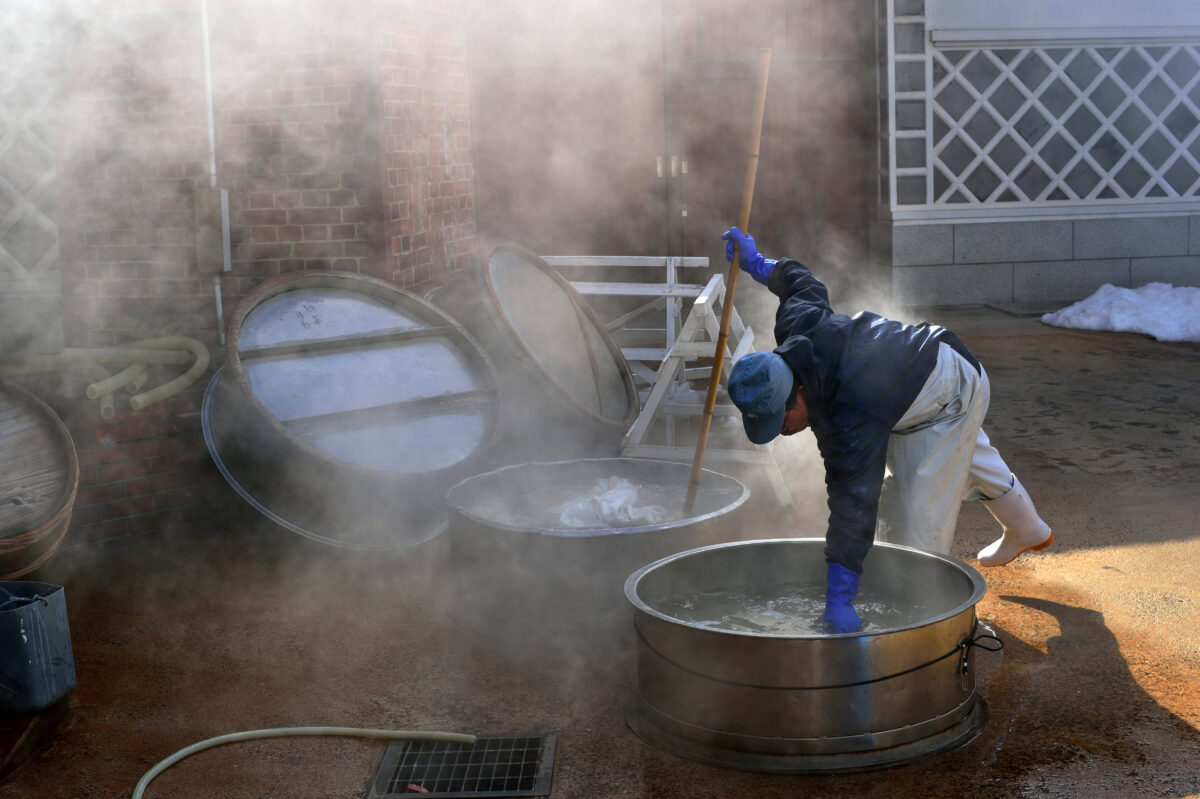Page snapshot: An overview of alcoholic beverages made from grasses, including both fermented and distilled beverages.
Topics covered on this page: Introduction; Fermentation; Distillation; Fermented beverages; Beer (barley and other grains); Sake (rice); Millet beer/pombe (millet and other grains); Chicha (maize or corn); Distilled beverages made from grass grains; Whiskey; Vodka; Gin; Wheat and rye; Rum, a distilled beverage from sugarcane; Resources.
Credits: Funded by the National Science Foundation. Any opinions, findings, and conclusions or recommendations expressed in this material are those of the author(s) and do not necessarily reflect the views of the National Science Foundation. Page by Naomi Schulberg (2023).
Updates: Page last updated August 30, 2023.
Image above: Sake brewing in Saijo, Japan. Photo by 東広島市 (Wikimedia Commons, Creative Commons Attribution-Share Alike 4.0 International license).
Introduction
Alcoholic beverages are fermented or distilled beverages that contain ethyl alcohol, also known as ethanol. There are many types of fermented or distilled beverages. Fermented products include beverages like wine, beer, and cider, whereas distilled beverages (spirits) include liquors like gin, vodka, rum, and whiskey.
Alcohol is often made out of fruits, commonly grass grains, grapes (wine), or apples (cider), although many other types of fruits may be used. In some cases, other plant or even animal sugars can be used to make alcohol, like honey (to make mead), molasses (to make rum), or agave cores (for mezcal and tequila). Some examples of alcoholic beverages made from grass grains include sake, beer, chicha, and whiskey. This page provides a brief overview of the processes involved in making alcoholic beverages, as well as examples of alcoholic beverages and the grasses used to make them.

Shelf with bottles of alcohol. Picture by Новиков Евгений Александрович Wikimedia Commons, Creative Commons Attribution-Share Alike 4.0 International license).
Fermentation
Sugar from plants must be fermented to produce ethanol. This is an anaerobic reaction (performed in the absence of oxygen, O2). During fermentation, yeast (a single-celled fungus, often Saccharomyces cerevisiae, although other species may be used) converts sugar into ethanol and carbon dioxide gas (CO2).
A simplified formula for this process is:
glucose → CO2 + ethanol
This formula can also be written as:
C6H12O6 → 2C2H5OH + 2CO2
In making alcohols from grass grains, the starch stored in the grains is fermented to make the alcohol. Starch molecules, however, are too complex to be fermented by yeast directly. Instead, the starch from the grass grains must be broken down into glucose, which is a simple sugar, by enzymes before it is fermented.

A scanning electron micrograph of yeast (Saccharomyces cerevisiae). Yeast are single-celled fungi that reproduce by budding, and buds can be seen forming on the yeast above. Photo by Mogana Das Muret adn Patchamuthu Ramasamy (Wikimedia Commons, Creative Commons Attribution-ShareAlike 3.0 Unported license, image resized).
Distillation
All distilled beverages undergo the process of fermentation prior to being distilled. Distillation is a process that separates alcohol and water. Alcohol has a lower boiling point than water, and so it evaporates at lower temperatures. Thus, during distillation, fermented liquid is heated to a temperature high enough to make ethanol boil, but low enough that water does not boil. The alcohol vapor is captured and condensed (cooled so that it returns to a liquid state), then collected in a separate container. Separating the liquids increases the concentration of alcohol in a beverage.
Distilled beverages are often diluted following distillation to lower their alcohol content to a standard percentage of the total volume of liquid. In the U.S., the alcohol content is displayed as the percent alcohol by volume, abbreviated ABV. Distilled beverages often range from about 35% ABV (in the U.S., also called 70 proof) to 95% ABV (in the U.S., also called 190 proof).
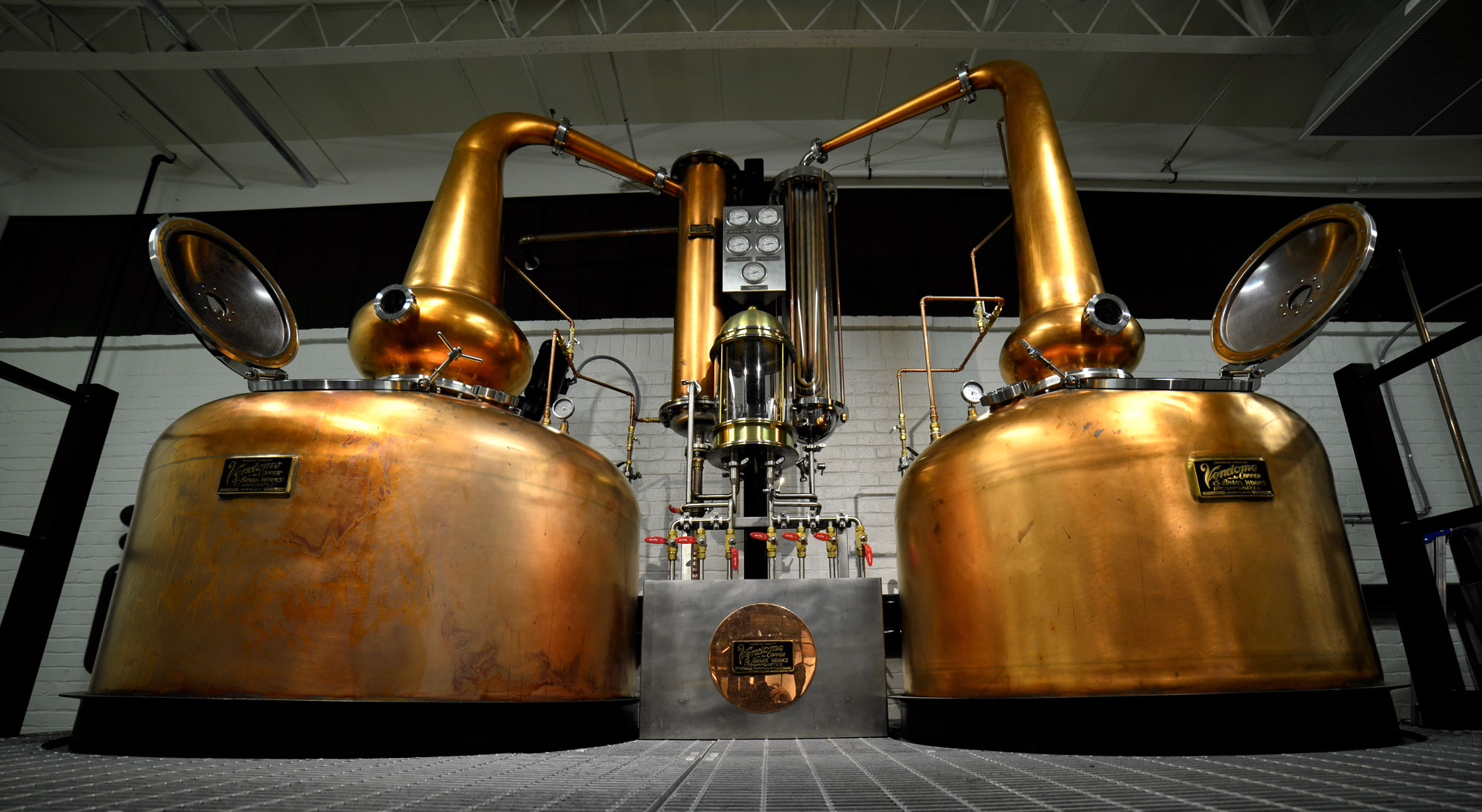
Large copper stills at a craft bourbon distillery in Atlanta, Georgia, U.S.A. Photo by Thechadwix (Wikimedia Commons, Creative Commons Attribution-ShareAlike 4.0 International license, image cropped and resized).
Fermented beverages
Beer (barley and other grains)
Beer the beverage
Beer, the most commonly consumed alcoholic beverage in the world, is made from a variety of grains. The most common and essential grain in beer is barley (Hordeum vulgare). Beer can additionally be made using wheat, oats, rice, maize (corn), and other grains. Most of these grains are used as adjuncts, substances that are added to the beer to change the flavor, change the alcohol content, or make the beverage cheaper to produce. The three essential ingredients in beer, besides the malted barley, are water, hops (Humulus lupulus, a vine), and yeast.
Barley grains used to make beer are malted. Malted barley is made up of germinated barley grains. Malting unleashes enzymes in the barley grains that start the conversion of starches (complex molecules) to sugar (simpler molecules). After malting, the grains are roasted to dry them and stop the germination process. The enzymes produced by malted barley can also stimulate the conversion of starches into sugars in other, unmalted grains when they are mixed with the malted barley. That is why malted barley is an essential ingredient in making beer.
Beer is very important in human history. Its production may have started as many as 13,000 years ago. It was very important in ancient Mesopotamia and was a staple of many diets across the Middle East. It had and continues to have cultural, religious, and societal importance in different regions of the world.
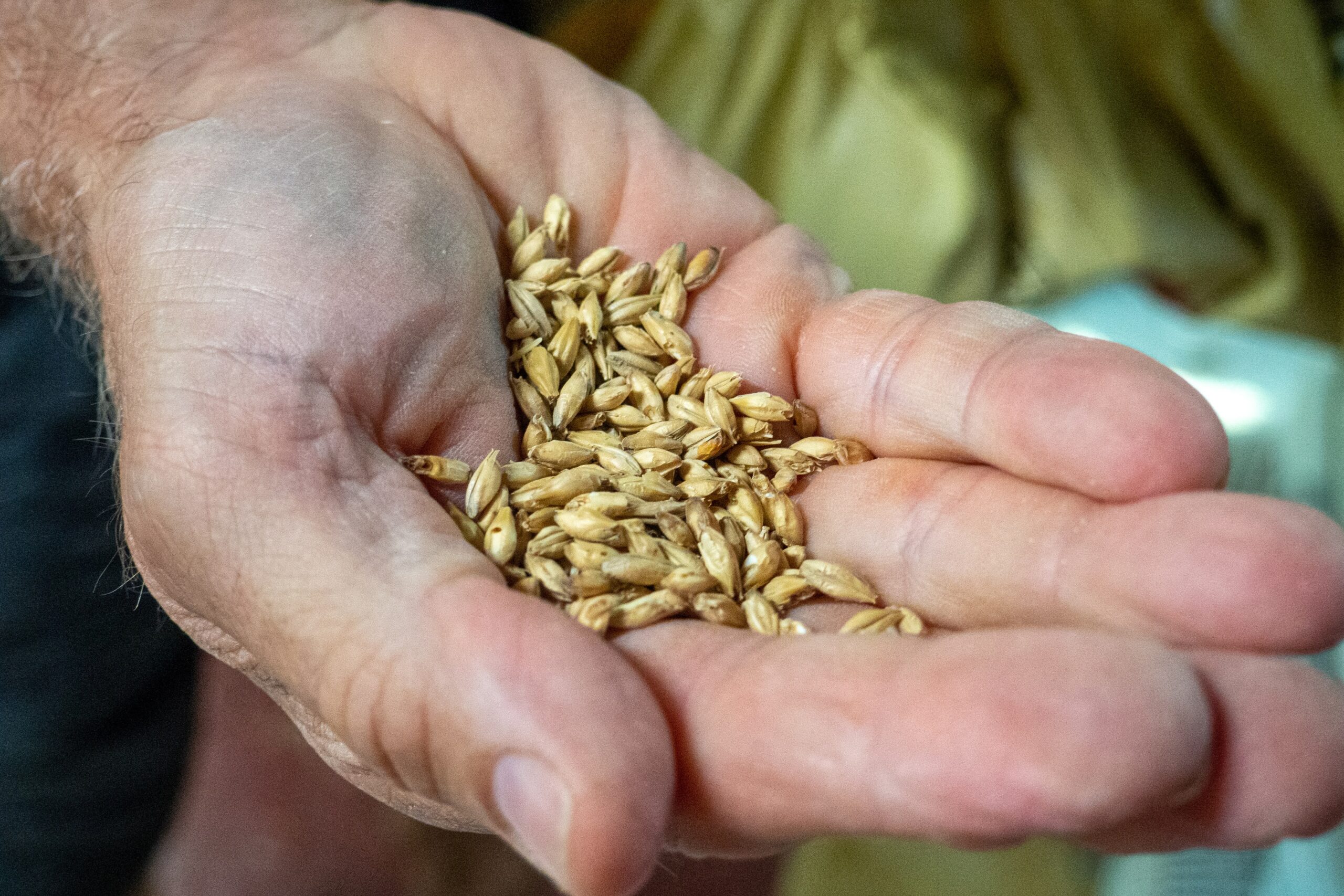
Malted barley grains. Photo by Nora Lambert (Wikimedia Commons, Creative Commons Attribution-Share Alike 4.0 International license).

A model from ancient Egypt showing people making beer. Model on display at the Rosicrucian Egyptian Museum, San Jose, California, U.S.A. Photo by E. Michel Smith Chiefio (Wikimedia Commons, Creative Commons Attribution-ShareAlike 3.0 Unported license, image cropped and resized).
The grass: barley (Hordeum vulgare)
Barley (Hordeum vulgare) was originally domesticated in the Fertile Crescent or surrounding region (essentially, the modern Middle East) from wild barley (Hordeum spontaneum) as long as 10,000 years ago, or even earlier. The cultivated form of barley has shorter stems, wider leaves, larger grains, and other distinct differences from its wild ancestor. Cultivated barley is a winter or spring annual grass.
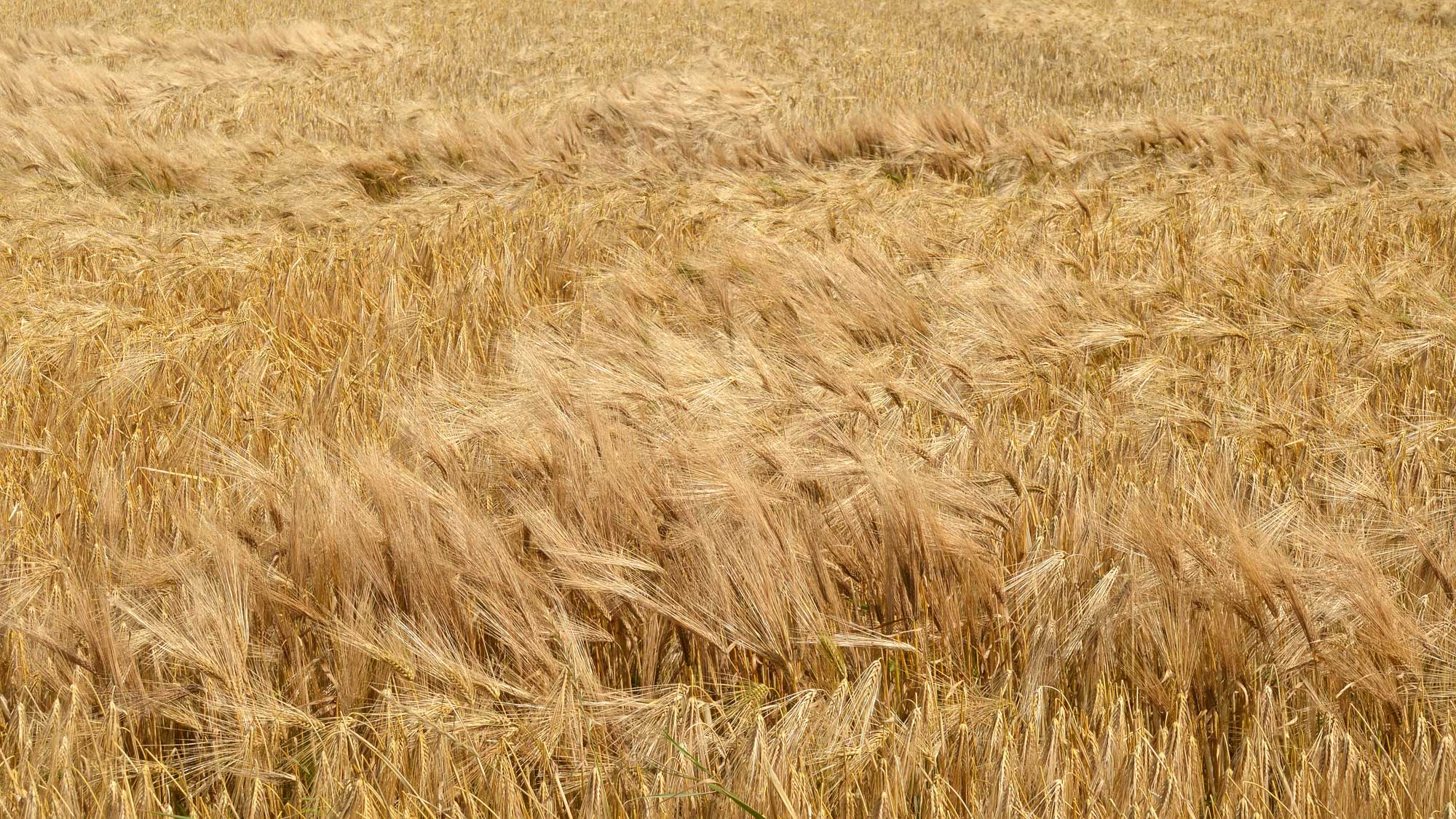
Barley (Hordeum vulgare), Hå, Norway. Photo by Ryan Hodnett (Wikimedia Commons, Creative Commons Attribution-ShareAlike 4.0 International license, image resized).
Sake (rice)
Sake the beverage
Sake is an alcoholic beverage made from rice (Oryza sativa). The technique of fermenting rice grains originated in China and spread to Japan about 2500 years ago. Today, sake is most strongly associated with Japan, although it is commonly consumed in many regions of the world.
The process of making sake involves first polishing the rice. Polishing is the process of milling rice grains to remove the outer layers of proteins and lipids (the bran) and the embryo (the germ). The rice is then washed, soaked, steamed, and cooled.
The next step in producing sake is fermentation; some of the rice is covered with mold spores (koji mold, Aspergillus oryzae); the mold secretes enzymes that transform the rice starch into fermentable sugars. This turns the rice into a product referred to as koji.
Koji, the remaining rice, water, and yeast, are then mixed together. In a process that takes about three weeks in its entirety, the enzymes in the koji convert the starch in the rice into sugars, and the yeast then ferments the sugars into alcohol.
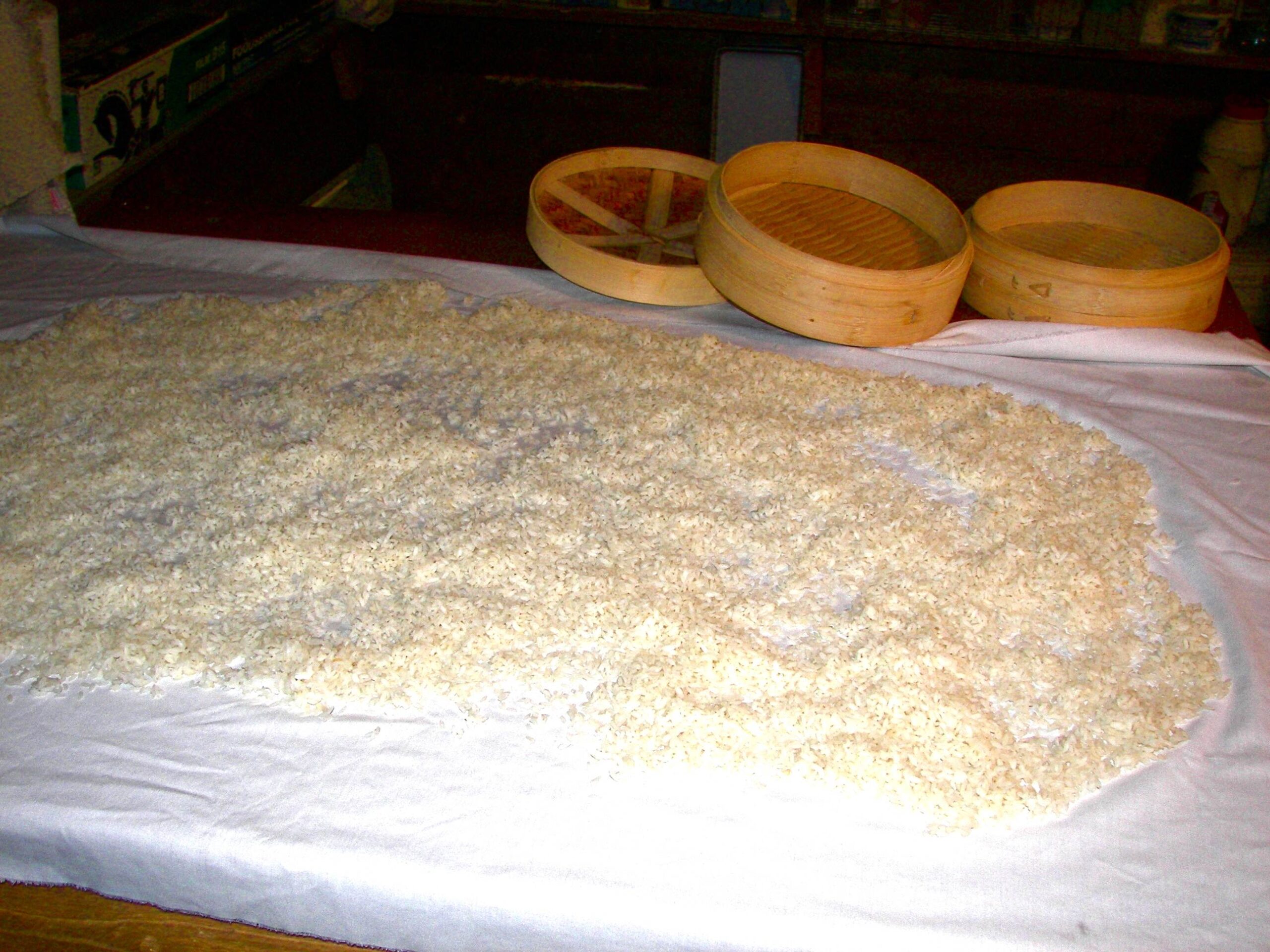
Sake rice spread out to be cooled during the brewing process. Photo by Jim O'Neil (flickr, Creative Commons Attribution 2.0 Generic license).

Bottles of sake with glasses. Photo by Culture Japon (Wikimedia Commons, Creative Commons Attribution-ShareAlike 4.0 International, image resized).
The grass: rice (Oryza sativa)
Sake is made from rice (Oryza sativa), which is native to eastern Asia. It is thought to have been first domesticated in China about 10,000 years ago. Today, it is cultivated worldwide and is a staple food in many regions.
There are two main domesticated subspecies of Oryza sativa: Oryza sativa subspecies japonica and Oryza sativa subspecies indica. Sake is more commonly made from subspecies japonica, which has relatively short and “sticky” grains. There are special varieties of rice that are suitable for sake making, called shuzo-kotekimai. The rice grains used to make sake generally have a high ratio of central starch to outer proteins and lipids.
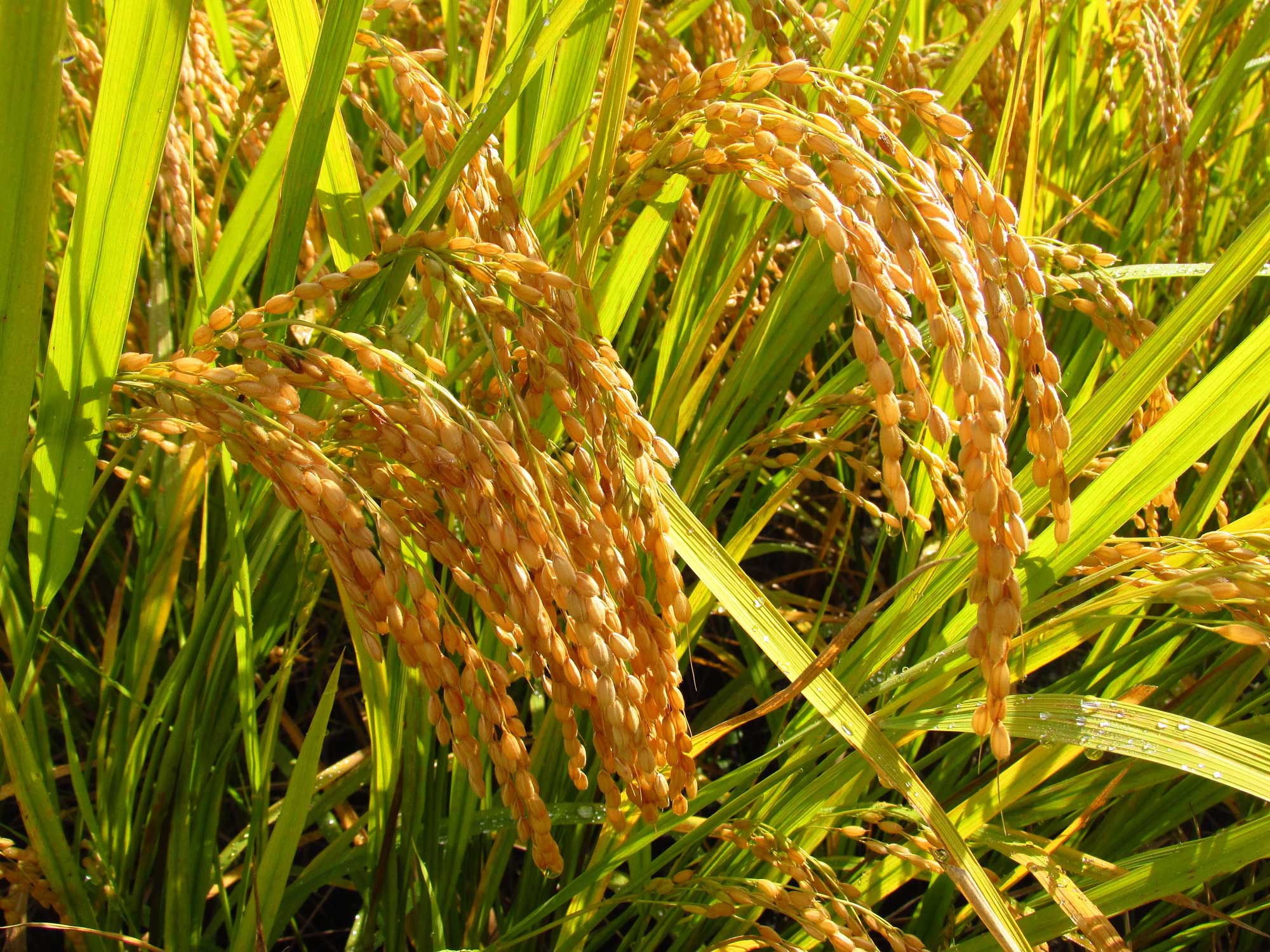
Rice (Oryza sativa), Aomori Prefecture, Japan. Photo by Aomorikuma (Wikimedia Commons, Creative Commons Attribution-ShareAlike 4.0 International license, image resized).
Millet beer/pombe (millet and other grains)
Millet beer the beverage
Millet beer, sorghum beer, or pombe (from Swahili, meaning beer) is a general term for a variety of beverages made from fermented grains in parts of Africa, although these beverages may be known by different names locally. To make these traditional beers, grains are malted by soaking them in warm water, allowing germination to occur. The malted grains are ground up and mixed with water, then boiled to kill bacteria. Yeast (Schizosaccharamyces pombe) is added and fermentation occurs, creating beer.
Beer has cultural significance throughout different regions of Africa. It is consumed at various social activities, and at big events such as births, weddings, funerals, and more.

Original caption: "Pombe Brewing in Moshi, Tanzania." Photo by Christin Schipmann/ICRISAT HOPE (flickr, Creative Commons Attribution-NonCommercial-ShareAlike 2.0 Generic license).

A woman ladling a type of traditional beer, called tchouk, into a bowl in Natitingou, Benin, 2017. This beer may be made with millet, sorghum, and/or maize. Photo by Abby Wendle (Wikimedia Commons, Creative Commons Attribution ShareAlike 4.0 International license, image resized).
The grass: finger millet (Eleusine coracana)
Millet is not one type of grass, but is a term that encompasses more than one species of grass that is grown for its small, edible grains. All millets originally come from Africa and Asia, but not all millets are closely related to one another.
Finger millet is one of the types of millets used to make millet beer. It is an annual grass that is cultivated in the mountainous regions of East Africa. Sorghum (Sorghum bicolor, sometimes considered a millet) and maize (Zea mays, which is native to the Americas) are also used to make traditional beers.

Ears of finger millet (Eleusine caracana) grains that have been harvested from the plants. Photo by Pete Lewis/UK Department for International Development (Wikimedia Commons, Creative Commons Attribution 2.0 Generic license, image resized).
Chicha (maize or corn)
Chicha the beverage
Chicha is an alcoholic beverage made using maize (Zea mays). The production of chicha dates at least to the Incan empire, where it was regularly consumed and held religious and cultural significance.
Chicha is made in a variety of ways. Traditionally, maize kernels were chewed and then spat into a clay bowl, where the microbes in saliva would break down the starch to start the process of fermentation. (The enzyme ptyalin in saliva catalyzes the breakdown of starch into maltose, a sugar.) Alternatively, it is made via malting. In this process, the maize kernels are germinated to stimulate the conversion of starch to sugar, and then they are boiled with yeast. Additional unrefined sugar, called chancaca, is added to aid fermentation. After fermentation, the mixture is sieved to separate the solids and liquids.
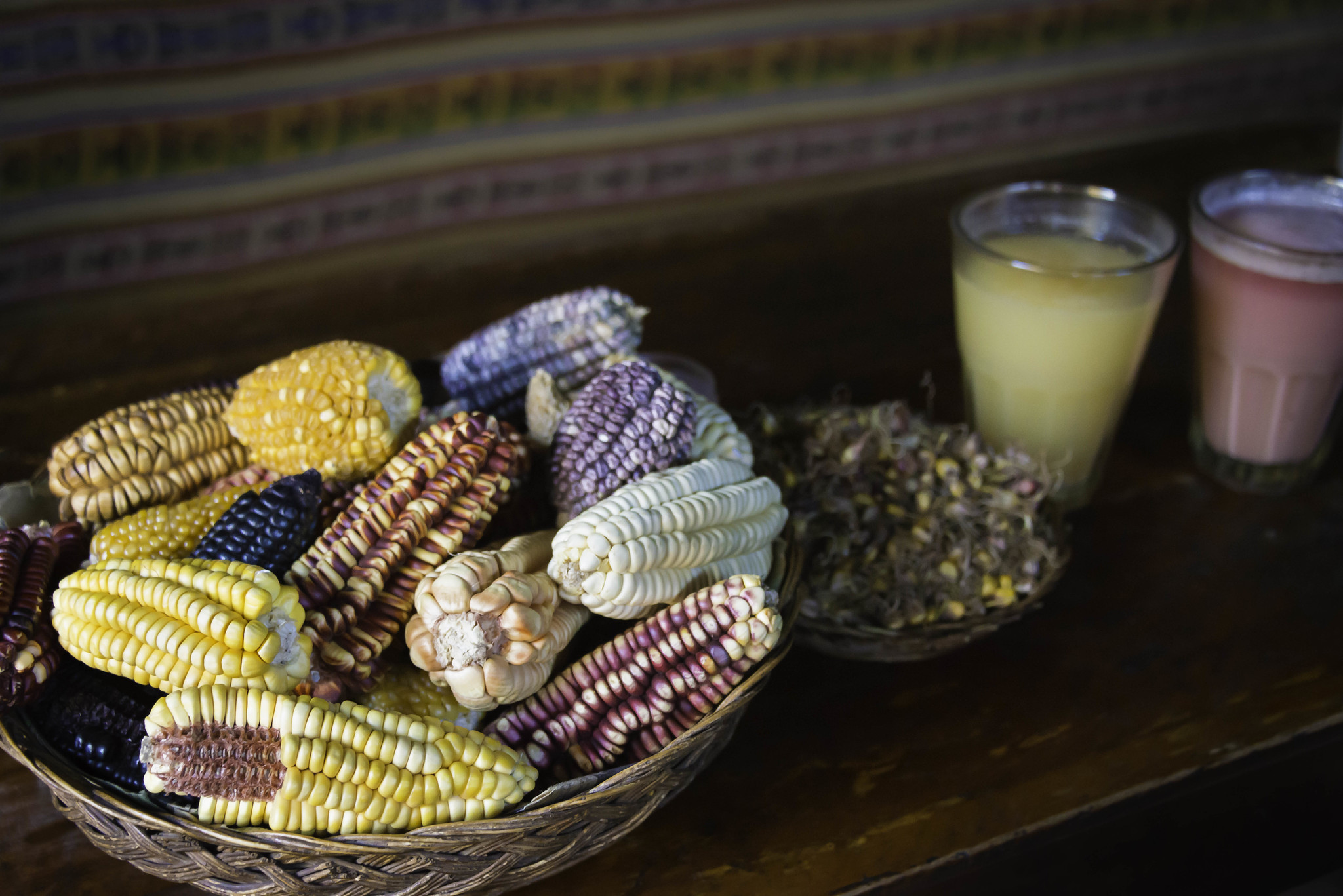
Corn and chicha. Photo by Anthony Tong Lee (flickr, Creative Commons Attribution-NoDerivs 2.0 Generic license).
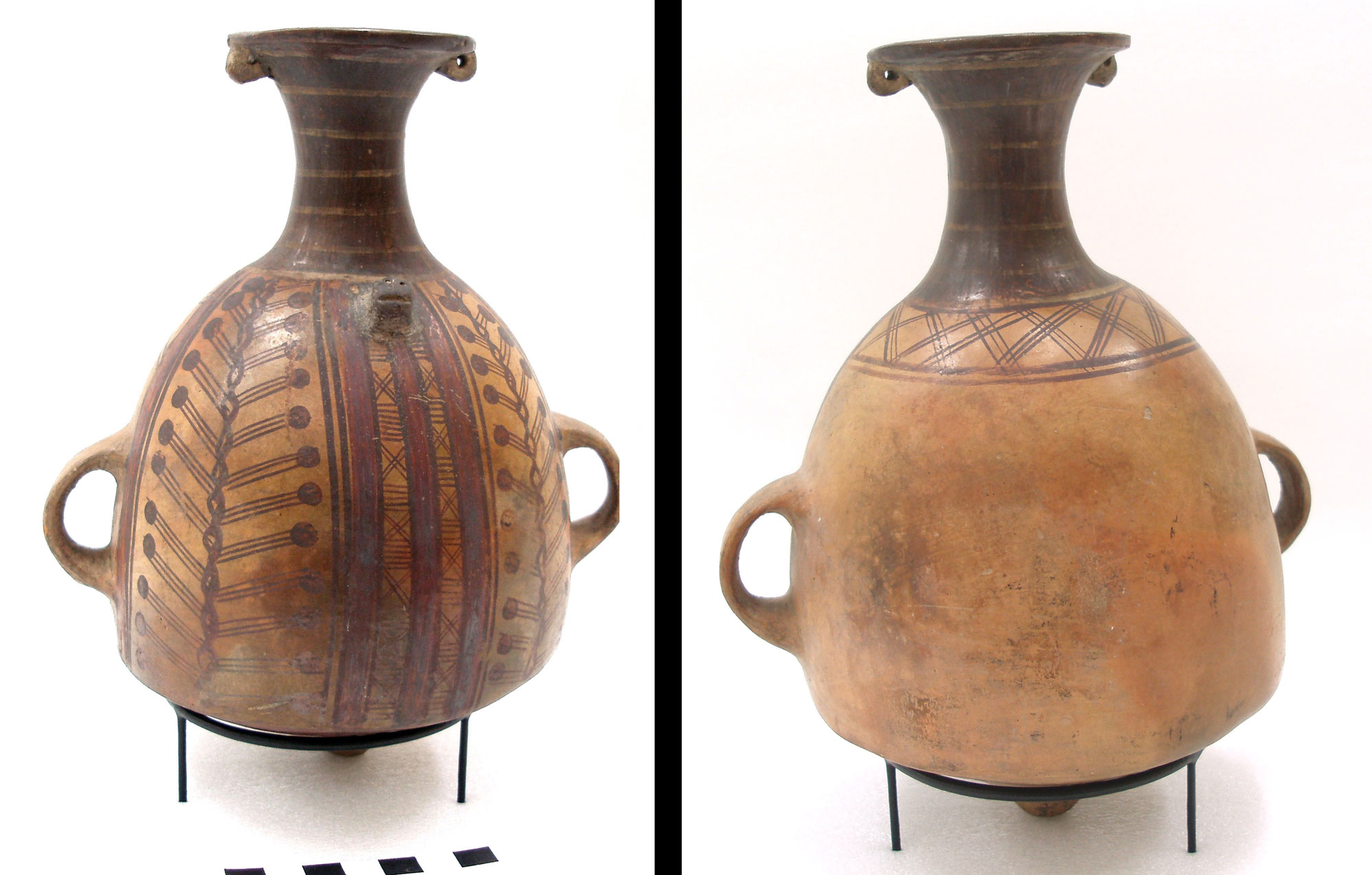
Aryballos, Incan vessels that were used to hold chicha, other drinks, and food. Peru, 1400s to 1500s. Left photo and right photo by Auckland War Memorial Museum Tāmaki Paenga Hira (Wikimedia Commons, Creative Commons Attribution 4.0 International license, images cropped and resized).
The grass: maize (Zea mays)
Maize (Zea mays, also known as corn in parts of the world), is an annual grass. It grows to be between 5 and 8 feet (1.5 to 2.4 meters) tall and is wind pollinated. It was first domesticated in Mexico beginning about 9,000 years ago, and it is now one of the world's most widely cultivated crops.
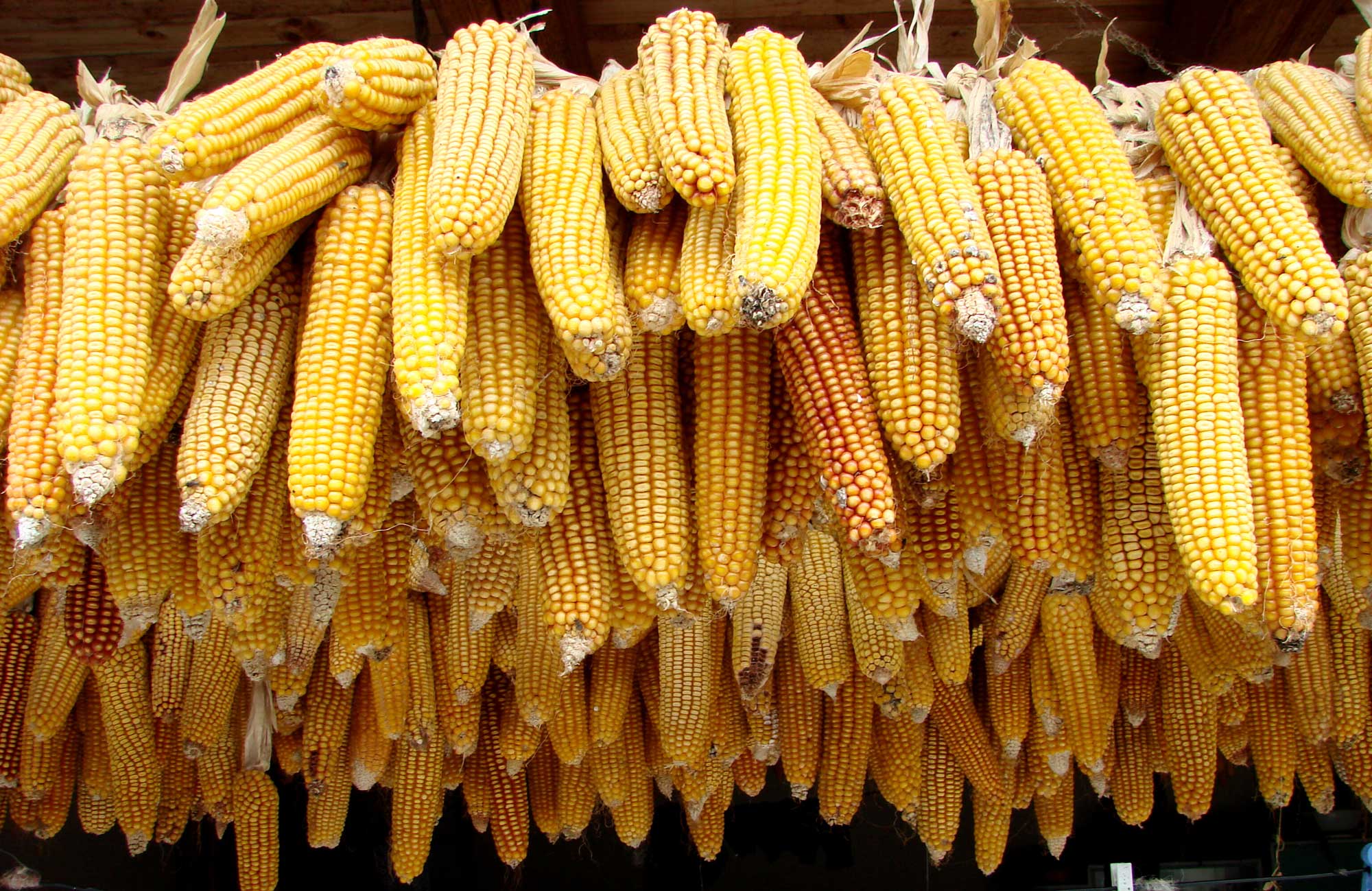
Ears of corn, Romania. Photo by Adam Jones/Adam 63 (Wikimedia Commons, Creative Commons Attribution-ShareAlike 3.0 Unported license, image cropped and resized).
Distilled beverages from grass grains
Distilled beverages are commonly made from grass grains. Three of the most popular types of grass grain-based spirits are discussed below: whiskey, vodka, and gin. These types of alcohol are defined by a combination of the ingredients fermented to make them, their alcohol content following distillation, their alcohol content following dilution, whether and how they are aged, and/or whether they are infused with flavoring ingredients following distillation.
Whiskey
Whiskey is a class of distilled beverage that is made from grass grains. The grains are fermented, and then the fermented liquid is distilled. Whiskey is barrel aged. The flavor of whiskey is determined by the grains used to make it, how it is distilled, and how it is aged following distillation (including how long and in what type of barrel).
Some varieties of whisky include Scotch (made using malted barley dried with smoked peat), rye (made with rye grain, Secale cereale), and bourbon (made using at least 51% maize grain and typically from Kentucky, U.S.A.). Different types of whiskey are aged for different amounts of time, and the types of barrels whiskeys are aged in affect their flavor.

Bourbon cocktail. Photo by Jazz Guy (flickr, Creative Commons Attribution 2.0 Generic license).
Vodka
Vodka refers to odorless, flavorless, colorless distilled alcohol. Vodka originated in Eastern Europe, although it is now produced and consumed globally. Vodka can be made from many different grains and bases, including rye, wheat, corn, barley, potatoes, grapes, and even milk! Vodka is distilled to be very high in ethanol (at least 95%) prior to dilution and is not aged.
The world's top-selling vodkas are made from grains, some of them specifically from wheat, rye, or rice. The top-selling vodka in the U.S. is made from maize (corn).

A glass of vodka next to a bottle of vodka. Tito's vodka is made from maize (corn) kernels. Photo by Naomi Schulberg.
Gin
Gin is an alcohol that is created by infusing a neutral vodka-like spirit with botanicals (extracts derived from plants). The essential botanical added to gin is juniper "berries" (these are actually fleshy cones from the common juniper, Juniperus communis), which contribute to its distinctive flavor. The other botanicals added to gin vary by brand or maker. Gin is most commonly made from wheat, barley, and rye. Today, gin is consumed throughout the world; it originated in Europe in the Early Modern Period (1500s).

A glass of gin and tonic, a popular cocktail made using gin and tonic water. Photo by NotFromUtrecht (Wikimedia Commons, Creative Commons Attribution-Share Alike 3.0 Unported license).
The grasses: wheat and rye
Whiskey, vodka, and gin are made from a variety of grains, but among the most common are barley, wheat, maize, and rye. Barley and maize were covered above on this page, so wheat and rye are covered below.
Barley, wheat, and rye are all in the same group of grasses, the Wheatgrass Tribe (Triticeae). All are cool-season grasses that were domesticated in the region of the modern Middle East thousands of years ago.
Wheat (Triticum aestivum)
Wheat (Triticum aestivum) is an annual grass that is among the most commonly cultivated grain crops in the world. Winter wheat varieties, for example soft red winter (SRW) wheat, are often used to make distilled beverages.
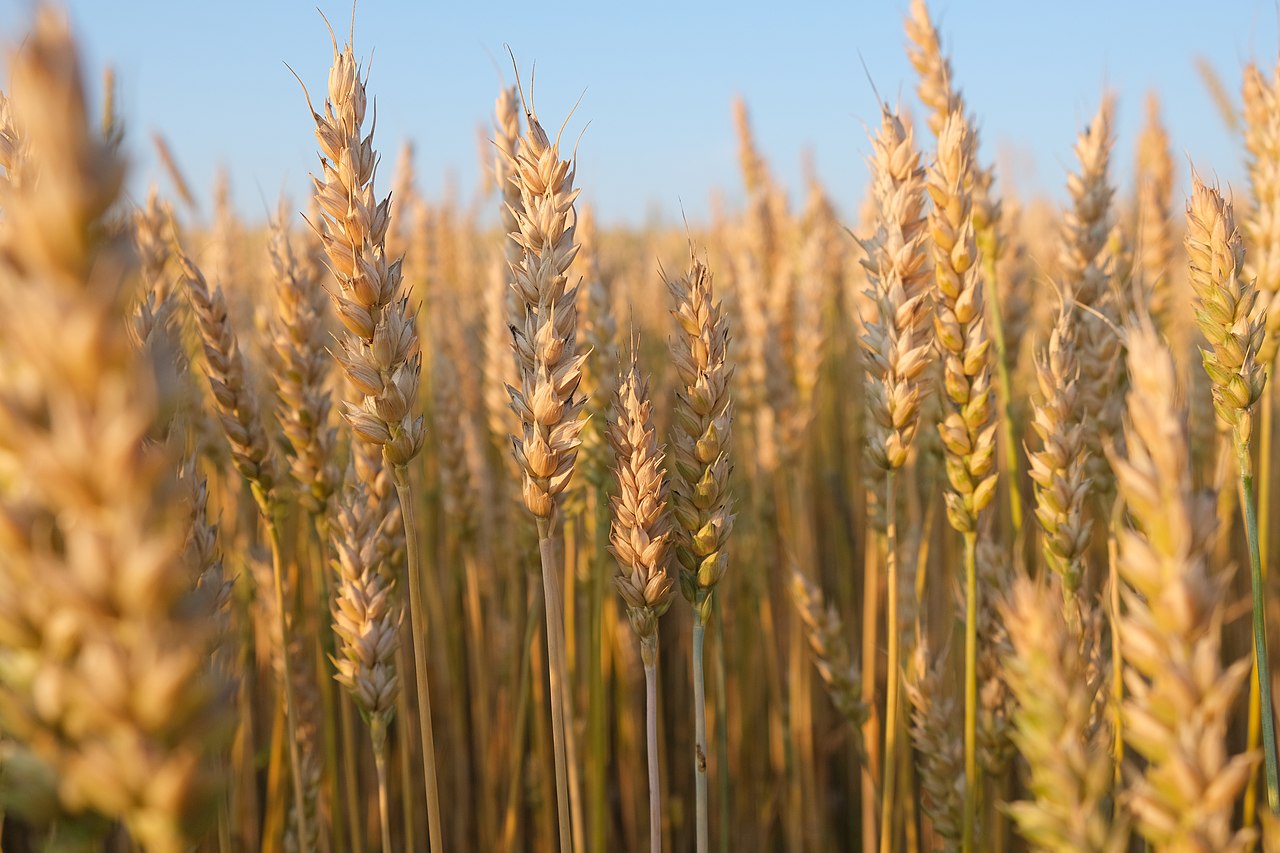
A field of wheat, Finland. Photo by Kallerna (Wikimedia Commons, Creative Commons Attribution-Share Alike 4.0 International license).
Rye (Secale cereale)
Rye (Secale cereale) grows wild in the Mediterranean but is commonly cultivated in temperate regions throughout the world. Archeological evidence suggests that it may have been first cultivated around 13,000 years ago, making it one of the first cereal crops to be cultivated.
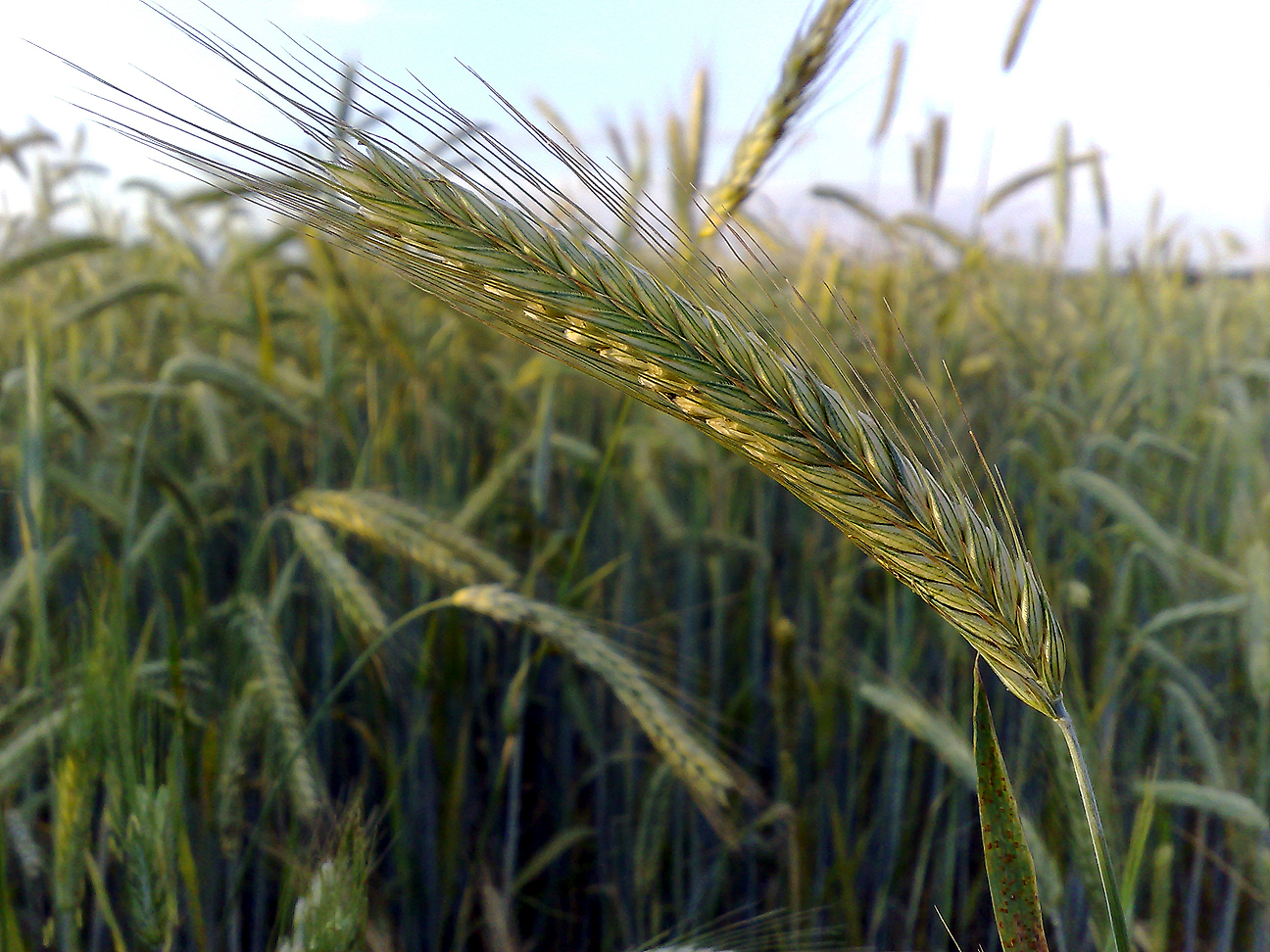
Rye growing in a field. Photo by LSDSL (Wikimedia Commons, Creative Commons Attribution-Share Alike 3.0 Unported license).
Rum: a distilled beverage from sugarcane
Rum is an alcoholic beverage made using sugarcane, a large tropical grass. It was first produced in the Caribbean and made from molasses, a dark, viscous liquid that is a byproduct of making sugar. The history of rum dates back to the early 1600s and is strongly tied to slavery. Rum was originally a drink made by enslaved people on sugarcane plantations.
Rum was later produced in colonial America. Trade resulted in rum spreading to Europe, where it developed associations with both the navy and pirates. In fact, sailors in the British navy were historically entitled to a rum ration.

Original caption from Slavery Images: "This image shows a white overseer managing enslaved people filling hogsheads [barrels] with rum and a cooper making barrels." This image was included in a book published in 1823 about the sugar industry on Antigua. Art by William Clark (1823) (Slavery Images, public domain).
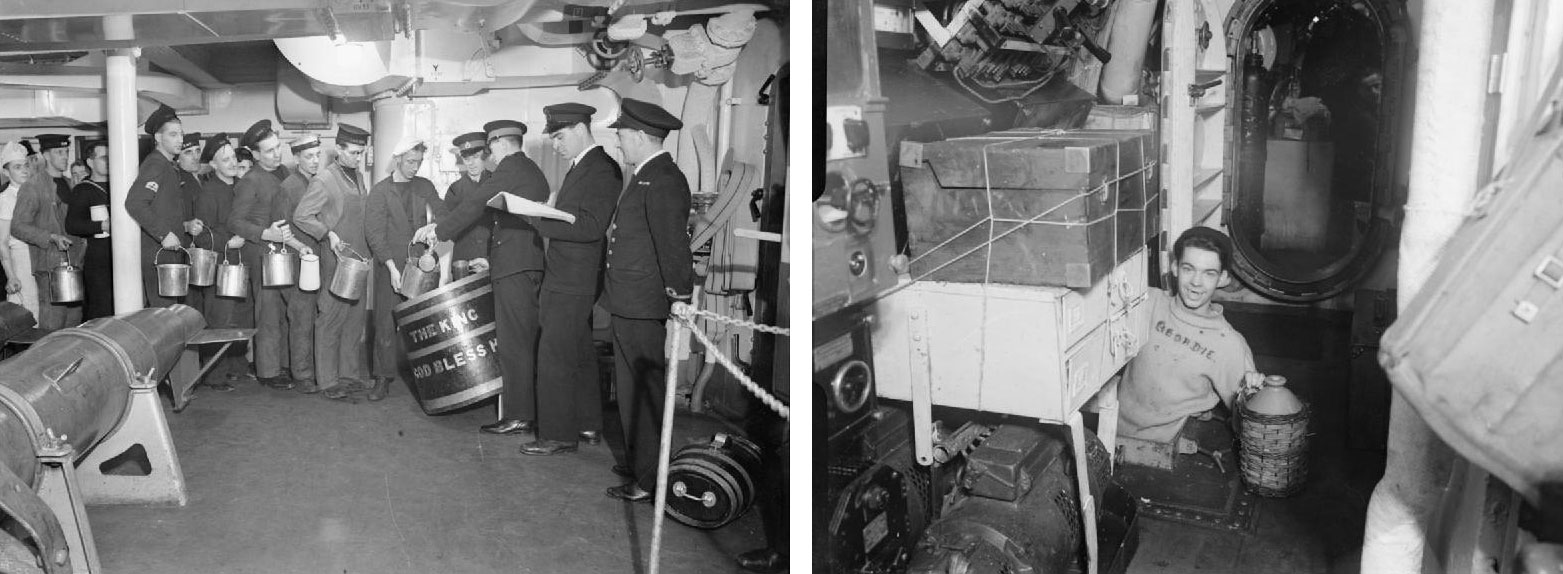
Rum rations in the British Navy during World War II. Left: Rum being distributed to sailors on the HMS King George, 1940. Right: A sailor with a jug for rum on the HMSM SERAPH, between 1939 and 1945. Left image and right image by the Imperial War Museums UK (via Wikimedia Commons, public domain).
Rum is made by fermenting and then distilling sugar cane juice or molasses. If the juice of the sugarcane plant is used, it is extracted using a mill. Molasses, a byproduct of sugar production, is separated from massecuite (concentrated, crystallized sugarcane juice) in machines known as centrifugals. The molasses is then diluted with water, yeast is added, and fermentation occurs. Afterwards, the fermented liquid is distilled to concentrate the alcohol. Like whiskey, rum is aged in barrels.

A sugar cane distillery in Grenada. Photo by dpursoo, licensed under a Creative Commons Attribution-Share Alike 3.0 Unported license.
The grass: sugarcane (Saccharum)
Sugarcane (Saccharum) is typically used to make rum. Today's cultivated sugarcane is descended from a type of sugarcane first domesticated in New Guinea. It is a perennial grass that grows to 3 to 4 meters (about 10 to 13 feet) tall. Because it requires consistently warm temperatures to thrive and is not tolerant of cold, it is grown in tropical to subtropical regions of the world.
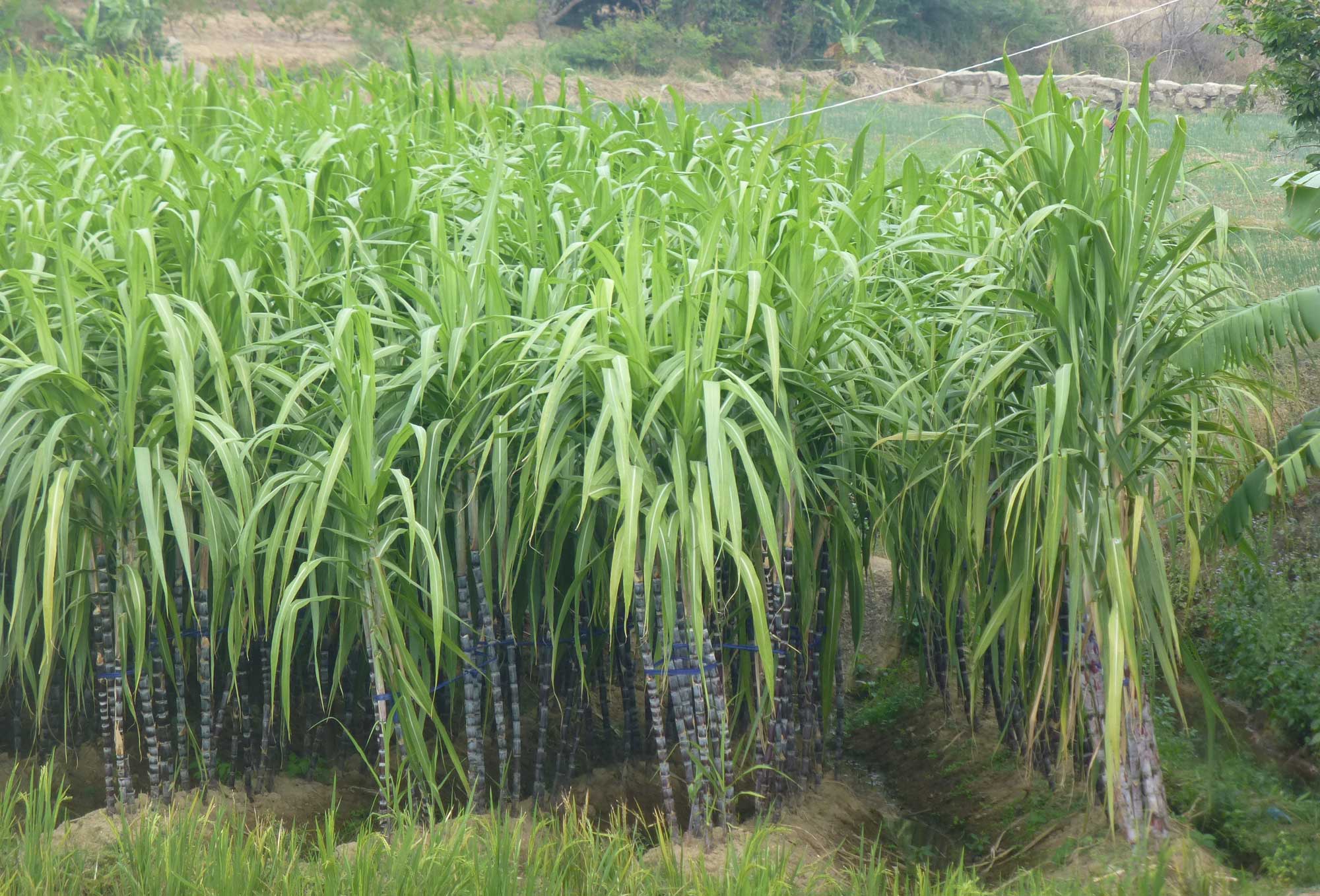
Sugarcane patch, Fujian, China. Photo by Vmenkov (Wikimedia Commons, Creative Commons Attribution-ShareAlike 3.0 Unported license, image cropped and resized).



